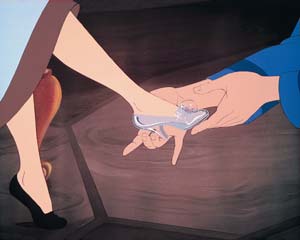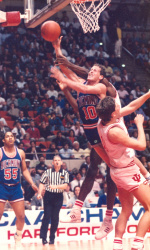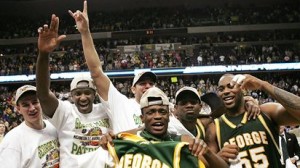NCAA Men’s Basketball Tournament: Time For Cinderella To Dance

The NCAA Basketball Tournament gives small schools the chance to wear Cinderella's glass slipper.
So how does your NCAA bracket look? If yours is anything like mine, the toughest choices have not been in picking Final Four teams, but instead in trying to predict which school will come out of nowhere to crash the party.
Almost every year at least one school that is familiar only to people within its home area code suddenly becomes a national darling thanks to an upset, or near upset, of a team with significantly more national recognition. These schools are often referred to as “Cinderella” and just to avoid the kind of confusion that occurred at my house the other night when my five-year old daughter heard a promo for the NCAA Tournament and thought it meant one of her favorite princesses was going to be playing basketball, in this case Cinderella does not have flowing blonde hair, a glass slipper or a Fairy Godmother.
Rather, the typical Cinderella of the NCAA Tournament is a school that has been playing good basketball throughout the year, but has stayed under the radar while schools from the power conferences hog the national television spotlight and spots in the national polls. One of the endearing elements of the NCAA Division I Men’s Basketball Tournament is that the opening rounds of the tournament are the one time each year when those power conference schools must share that spotlight with schools that aren’t so familiar to a national audience.
Unlike during any regular season match-ups that are almost always played at the home site of the power conference school and come with all the trappings of a home court edge including rowdy student sections and officials assigned by the host schools conference, when power conference schools face schools from smaller conferences on a neutral court in the NCAA Tournament anything can happen.
Over the years, the results have included some of the most memorable upsets in NCAA Tournament history. Over the last 30 years many schools have played the role of Cinderella, but I have chosen to highlight five schools that wore the glass slipper with particular distinction and helped create the concept of “March Madness.”
James Madison University – 1981, 1982, 1983 – Few outside of Virginia’s Shenandoah Valley had heard of James Madison University, which had been known as Madison College until 1977, when the Dukes made their first trip to the NCAA Division I Men’s Basketball Tournament in 1981. However, under the guidance of head coach Lou Campanelli, they quickly developed a reputation as a team higher seeds did not want to play. The 10th seeded Dukes defeated seventh seed Georgetown 61-55 before losing to second seed Notre Dame 54-45. The following season, JMU defeated Ohio State in the opening round before quite nearly pulling off the upset of the century. Facing top-seeded North Carolina, JMU gave the eventual national champions everything they could handle in a 52-50 decision that wasn’t decided until the final minute. The following season, JMU made it three straight years with an NCAA Tournament victory as they defeated West Virginia 57-50 before being eliminated by North Carolina in the second round.

Ken Atkinson and Richmond upset defending NCAA Champion Indiana in the opening round of the 1988 tournament.
University of Richmond – 1984, 1988, 1991, 1998 – During the 1980s and early 1990s, no team wanted to play Dick Tarrant and his “Giant Killers” from the University of Richmond in the NCAA Tournament. The Spiders made their initial NCAA Tournament appearance in 1984 a memorable one as they defeated fifth seeded Auburn, led by Charles Barkley, before dropping a tough 75-67 decision to Indiana. Four years later, the Spiders got their revenge on Bobby Knight and the defending NCAA Champions as the 13th seeded Spiders defeated fourth seeded Indiana 72-69 in the first round of the tournament. However, they weren’t done as they reached the Sweet 16 with a 59-55 victory over fifth seed Georgia Tech. The top seeded Temple Owls finally eliminated them in the round of 16. In 1991 the Spiders became the first 15th seed in NCAA Tournament history to win a game in the tournament as they shocked second seeded Syracuse, led by Derrick Coleman, 73-69. Though Tarrant’s retirement in 1993 signaled the end to a period of dominance for Richmond, they did return to the tournament in 1998 under the guidance of head coach John Beilein, now the head coach at the University of Michigan, and continued their upset tradition with a 62-61 win over third seeded South Carolina.
The Spiders are back in the NCAA Tournament in 2010 and as a number seven seed actually will be in an unusual position as the higher seed in their opening game against Saint Mary’s College. Now a member of the Atlantic 10 after previously playing in the Colonial Athletic Association (CAA), the Spiders have been successful against top caliber competition all season and could resurrect memories from past NCAA Tournament glories with a couple early tournament victories.
Loyola Marymount – 1990 – Few teams have tugged at the heart strings of college basketball fans the way Loyola Marymount did during the 1990 NCAA Tournament. An exciting team that set a new NCAA record by averaging 122 points per game under the guidance of former Los Angeles Lakers head coach Paul Westhead, LMU entered the 1990 West Coast Conference Tournament looking to secure a third straight bid to the NCAA Tournament. However, tragedy struck late during their first round conference tournament game against Gonzaga when All-American center Hank Gathers collapsed and later died due to a heart condition. The tournament was immediately suspended with the regular season champion Lions awarded the automatic bid to the NCAA Tournament. Few expected the Lions to make much noise when they started play in the NCAA Tournament as the 11th seed in the West just 13 days after the death of their star player. However, led by emotional leader Bo Kimble, the Lions captivated the nation by defeating sixth seeded New Mexico State 111-92 in the opening round and then whipping defending national champion Michigan 149-115 to reach the Sweet 16. LMU then edged Alabama 62-60 before losing to eventual national champion UNLV 131-101 in the West Regional Final.
Gonzaga – 1999, 2000, 2001 – Consistent success over the last decade has earned Gonzaga a tentative spot among the “Big Boys” of NCAA Division I basketball, but they most certainly wore the Cinderella slipper when they reached the Elite Eight of the NCAA Tournament in 1999 and then followed that run with consecutive trips to the Sweet 16. Gonzaga had made only one previous trip to the NCAA Tournament (losing to Maryland 87-63 in 1995) when they earned a bid to the 1999 tournament. The Bulldogs ripped through the field with wins over seventh seeded Minnesota, second seed Stanford and sixth seeded Florida before losing to eventual national champion Connecticut in the West Regional Final. In 2000 the Zags defeated seventh seeded Louisville and number two seed St. John’s before falling to Purdue in the Sweet 16. In 2001 they edged fifth seeded Virginia and dominated Indiana State before losing to top seeded Michigan State.

George Mason defeated three former NCAA Champions to make it to the Final Four in 2006.
George Mason – 2006 – Of all the Cinderella teams from non-power conferences that have made runs in the NCAA Tournament, George Mason is the only one ever to make it all the way to the Final Four. The 2006 Patriots had needed a surprising at-large bid just to get into the tournament, but proved that the committee knew what they were doing. GMU upset sixth seeded Michigan State 75-65 in the opening round. They then shocked defending national champion North Carolina to reach the Sweet 16. After defeating fellow Cinderella Wichita State in the round of 16, the Patriots defeated top seeded Connecticut 86-84 in overtime to advance to the Final Four. Though they lost to eventual national champion Florida 73-58 in the semifinals, George Mason proved to the country that teams from smaller conferences deserved the chance to hang with the big boys in the NCAA Tournament.
Who Could Be Next? – So which teams will wear Cinderella’s slipper in 2010? Among the lower seeds, there are several squads from non-major conferences that could make life difficult for higher seeds.
Wofford – The Southern Conference champions earned a 13-seed after posting a 26-8 record. The Terriers have won 13 straight games and 19 of their last 20 and will face the 4th seeded Wisconsin Badgers. They lost to Pittsburgh by three points early this season and have wins over South Carolina and Georgia.
Cornell – The Ivy League Champions are in the tournament for the third straight year and will look to post a victory after losing to Stanford and Missouri in their previous appearances. The Big Red are a senior laden team that has lots of experience and confidence. They have a 27-4 record and as the 12th seed will face number five Temple in the opening round.
Old Dominion – Coming out of the always dangerous Colonial Athletic Association, the Monarchs have a victory this season over Georgetown and a 26-8 overall record. As a number 11-seed, they will face Notre Dame in the opening round.
Murray State – With 30 victories coming out of the Ohio Valley Conference, Murray State is a balanced squad with five players averaging between 10.3 and 10.6 points per game. As a 13-seed, the Racers will face fourth seed Vanderbilt in the opening round.
UTEP – Though UTEP has a national title, that win came 44 years ago in a monumental upset over the University of Kentucky. In 2010, the Miners went 15-1 in the Conference USA regular season and finished with a 26-6 overall record. Many have them, as the number 12 seed, picked to upset number five Butler in the opening round.
I simply couldn’t depart your web site prior to suggesting that I actually loved the usual information an individual supply for your guests? Is going to be again continuously to check out new posts
I like the helpful info you provide to your articles. I will bookmark your weblog and take a look at once more right here frequently. I’m rather sure I will be told a lot of new stuff proper right here! Best of luck for the next!
Looks awesome